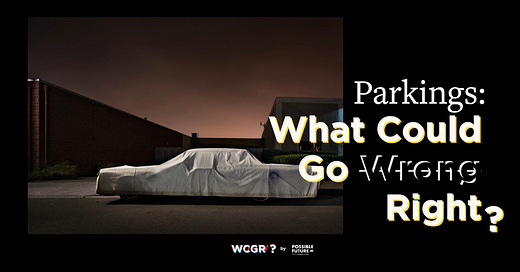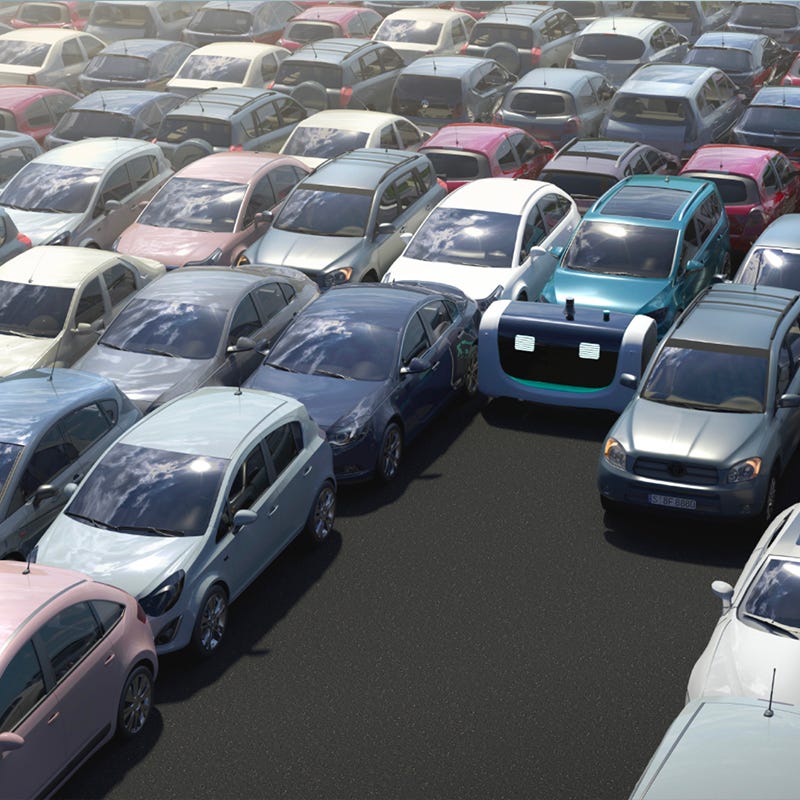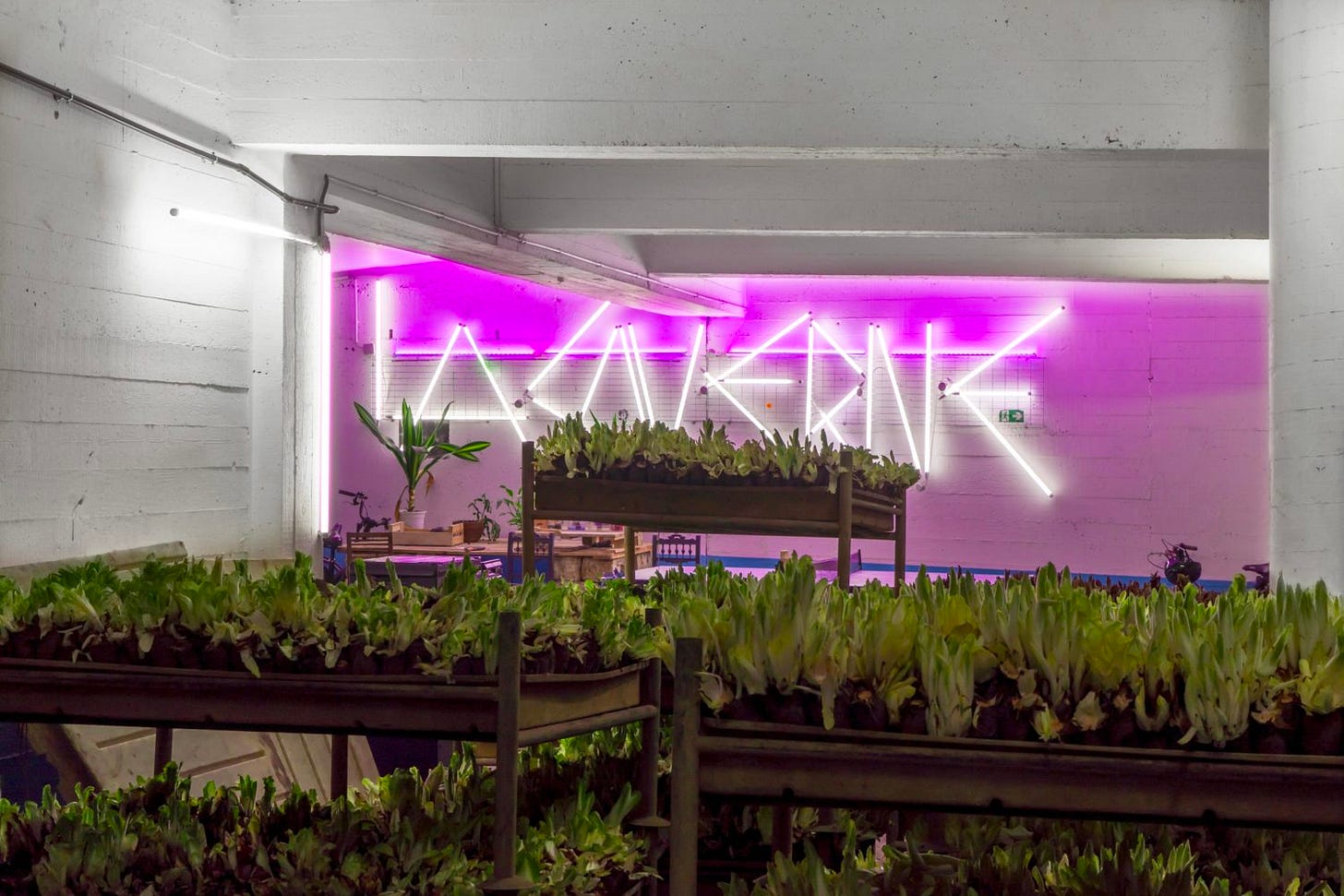What could go right - #13 - Parkings
In each issue (bi-monthly), we'll explore the threats to the current business model of a company or of an entire industry, the forces that could take them down or drive systemic changes, and most importantly we'll imagine possible solutions, looking at new and evolving trends, untapped niches, new business models or venture opportunities...
In this issue, we will take a look at a long-time coming shift in individual and collective behaviors around parking lots, directly resulting from a shift in our relationships with both our individual vehicles and our cities. We will explain how all stakeholders, from urban planners to parking operators, can and must anticipate this massive shift by going back to taking parking spaces for what they really are, valuable real-estate assets. Welcome to What could go wrong right.
On the 21st of April 2022, Disneyland Paris inaugurated 46k brand new solar panels, installed above its parking lot. The new installation will produce 10GWh a year, nearly enough to cover the needs of a 5k inhabitants city for one year. Disneyland's investment allowed for the creation of a new revenue line on the parking lot’s balance sheet, therefore increasing its value. This is one of the many recent examples illustrating an underlying trend that was already announced a long time ago and is actually slowly becoming real: the way we own and exploit parking spaces is due to be completely reinvented.
This slow but steady transformation can actually be separated into two distinct (but complementary!) mechanisms. First, parking lot operators tend to maximize the exploitation/operation of parking lots by adding new services for users and partners, enhancing the users’ experience, and even, like Disneyland did, adding new activities on top of the parking rental itself. Second, parking lots can be entirely re-thought beyond their initial function, and taken for what they really are: real-estate assets in the heart of expensive cities.
There are two main drivers pushing parking lot stakeholders to change perspective and to anticipate a new business-as-usual:
the individual-vehicle paradigm is facing a triple threat
the “city of the future” is not the same anymore
Gasolina
The individual-vehicle paradigm is facing a triple threat: bike commuting, gas prices, and…Tesla! There are 3 main aspects to take into account in this paradigm shift, playing a differently important role depending on the city and the users considered.
The rise of alternatives to individual ICEs, mostly soft and shared mobilities.
Gas prices and maintenance costs. Even though the French is one of the most refractory people in Europe to abandon the individual vehicle paradigm, there also is a 92% share of the population that perceives at least one constraint to owning one. The most cited drawback is the usage costs, especially gas, which will keep getting more expensive.
Last but not least…Tesla! (and autonomous driving in general). From a more long-term perspective, we can also consider that the rise of autonomous vehicles is going to reduce the number of cars per person. Another example comes from the German driverless vehicles company Vay which raised $95m last year and will launch in Hamburg this year. And we’re not talking about an isolated “startup” example. Rental giant Sixt also partnered with Intel’s Mobileye to launch a robotaxi service based on teledriving in Germany and Israel this year.
Walking On A Dream
The city of the future is not the same anymore : today, no one actually pictures “the city of the future” as they did 10 or 15 years ago. We used to imagine the city of the future as a huge metropolis, with complex traffic systems, flying cars, and skyscrapers culminating above the clouds.
However, in Europe, this imaginary has been largely questioned and is outdated. For instance, Carlos Moreno’s 15-Minute city vision has largely been adopted by cities, including Paris.
This polycentric conception of our cities mainly derives from social and environmental considerations, and the conviction the traditional model (suburbs to sleep - city center to work and shop) is unsustainable. COVID also accelerated that shift, as shown by C40’s framework to “Build Back Better with a 15-minute city”, published in July 2020.
This major shift in the paradigm of how we imagine our city has two implications:
individual cars (and therefore parking lots) are not part of the concept as they are expensive, unsustainable, and cumbersome.
there is not enough space in a 15-min radius to have both all the necessary infrastructures AND a parking lot for all households’ vehicles within the radius.
But this idea that, in an ever-increasing urbanization context and with a new way to conceive how we live in our cities, parking lots cannot take up the same space as they do, is not only vivid in Europe. In the US, many cities have started to free up space that was previously dedicated to parking. Buffalo, NY for example abolished the traditional ratios of the number of parking spaces required for new building development projects. Taking a step back, it actually seems absurd that it has not been the case before, knowing that in the US there are an estimated 8 parking spaces per car and that we could see urban landscapes like this one (a bit dated I admit!). Have a look at this video to understand.


What could go right?
To face this upcoming shift as demand drops radically, urban planners & parking operators have begun to question their activity of building new parking lots by reallocating those spaces in favor of new uses & businesses.
The vast array of solutions available for the parking industry can be divided into 3 main groups :
Maximizing the revenues by parking spots, by improving and enriching the experience
Prepare for future conversions, by designing new projects so they are easily compatible with retrofitting
Converting existing assets that cannot be retrofitted
I need more of you
The question parking operators have to face is : how can we enhance, enriche, and diversify our parking experience to optimize our core business ?
First things first, with an expected drop in demand (in volume), parking stakeholders can and should focus on maximizing each spot’s exploitation value (average basket, occupancy rate, additional services…you name it).
One solution can be to rely on data and AI to improve the pricing system of your parking lots, in order to maximize both revenues and occupancy rates. For instance, Fetch.ai and a Munich-based blockchain company Datarella recently launched a trial project in Munich of a demand-responsive pricing system. By using AI the pricing adapts according to the occupancy rate and activity of the area, then through a dedicated app, users can easily find and book an available parking spot. This project trial is expected to incentivize people to book and park in a specific parking lot rather than cruising for a parking space for hours.
This AI-powered parking garage rewards you for not driving
Another way to optimize existing assets is to maximize the number of cars parked per square meter. How? Autonomous driving! For example, airport parking lots operators have already chosen to invest in robotic car storage services such as Stanley Robotic, which is using robots to optimize space between cars and create extra spaces (up to 20% !). Autonomous driving can actually improve the same assets’ value.
https://stanley-robotics.com/automotive-industry/
Optimization only has meaning if it goes along with diversification, to improve revenue resilience for parking operators. As explained earlier, the individual ICE vehicle is doomed to be replaced by multiple, diverse, and less carbon-intensive alternatives. That’s why parking operators must restructure their offer to be able to welcome a larger ecosystem, for example with nearby businesses or public institutions. EV charging, eScooter & bike rentals should definitely be considered when talking about revenue diversification in parking operations. Actually, the choice is quite clear, they can either :
Wait for their customers to turn to alternatives as they gradually switch to mobility alternatives and coming to their location is becoming less and less convenient.
OR, they can adapt their offer to be more representative of the existing vehicles and keep their customers switching to EVs.
On that matter, Flashparking.com is a pioneer as they offer, since 2011, services to digitalize and electrify parking systems & assets. By using cloud-based technology they can enable & support an extended end-user journey leading to interactions between parking operators and retailers resulting in subsequent long-term business for both.
But this actually goes further than just long-term revenue perspectives. By positioning themselves as industry-changers, anticipating and leveraging EV’s parking constraints, they can actually become a driving force in EV’s adoption rates (and of course, unlock new revenues along the way). Facing the rise of sustainable transportation (EVs, e-scooters, bikes), the real opportunity is to shift ahead of time rather than shifting “in reaction” to new behaviors. By reallocating some of the existing parking spaces to future-fit these new models, parking operators could already be ahead of tomorrow's uses and generate retention on their premises.
I won’t be there
Another opportunity they could tackle is to be prepared for a shift in their core business by developing new parking lots allowing retrofitting.
In view of the decreasing use of car parking facilities, as they are currently designed, some players are building resilient infrastructures. Originally designed for motor vehicles, these spaces have been built in such a way that they can be transformed at the appropriate time.
This is the case, for example, for the HQ of 84.51° (and many others here) a data analytics and marketing company, in Cincinnati, Ohio, whose three levels of parking were built to be converted into office space when employees no longer have the use of their actual automobile. This strategy is deeply related to the fact that the city plan is leaning toward walkable and bike-able neighborhoods.
Following the same anticipatory pattern, another example is in Chicago, where a former Northwestern University car park is now The Garage, an on-campus startup incubator. The 11,000-square-foot co-working space is home to more than 60 student-founded startups per quarter and welcomes more than 1,000 visitors per month.
In a more radical application, the Saint-Jouan-des-Guérets Decathlon store aims to blend in with nature as much as possible until it can one day completely disappear without a trace. The outdoor spaces have been designed to encourage the surrounding life and guarantee a high level of biodiversity. Biodiversity issues were integrated into the project from the very beginning, resulting in a resilient installation with beehives, eco-pasture, and a wet area that uses the natural topography of the site. A draining concrete has been settled all around the premise to ensure that the ground breathes throughout the years until one day the building is cleared and the occupied area is at least as clean as when it was built.
He Turned The Water Into Wine
Converting the remaining parking lots, which can neither be optimized nor retrofitted is the last but not least business move parking operators could make.
In practice, not all car parks are designed to be convertible: the height of the ceilings, the acoustics, the angle of the floors, and the absence of underground windows are limiting factors to a living space, in fact, they are generally not compatible with conversion. It is therefore necessary that these spaces have to integrate a logic of reconversion from their initial design to allow these storage spaces to become really useful spaces in the future.
However, it should be noted that some parking spaces have already been converted into commercial and utility spaces using their inherent properties. This is the case with the mushroom beds in Paris, where the start-up La Caverne is developing underground agriculture. Their urban agriculture model allows them to be in the heart of the 18th arrondissement while being productive and ecological. By adapting their product range to the properties of the site, they are now able to achieve interesting yields on 4 types of products. In the long term, the company wishes to position itself as a site manager by renting their underground spaces, conducive to numerous local services like storage areas for local logistics or data centers, thanks to a natural chill & shady environment.
These are all new activities that make it possible to question and enrich the usefulness of underground spaces, in a +1.5° scenario by 2030 where many outdoor activities could be called into question. In this regard, Ikea is the standard-bearer with its shop in the heart of Vienna. This new shop has no parking space as everything that can be bought there does not require people to travel by car. Close to the metro and tram, accessible by bike or on foot, the shop was able to convert the two floors of parking space usually used into a hotel but also into an urban park open to the public, even outside the shop's opening hours. In addition, the layer of vegetation helps to cool the surroundings and prevent heat pockets in the city.
More recently, a former car park has been converted into an underground building to house stocks, goods, and personal property. The project, called "L'immeuble inversé" and financed by the Île-de-France Region, aims to bring local residents closer to their local services. The building should be accessible by mid-2022 and will offer space for rent to local retailers (dry and wet storage) as well as a bicycle logistics hub. On the surface, a new service interface will be created, marked by a pavilion with a light architecture, a green roof, and a pop-up kiosk staffed by a neighborhood concierge.
La Passion
Long story short, we’ve seen that there are viable and desirable alternatives to the way the parking industry is currently structured. But the most important is to take a step back and understand better the intricate links between the parking industry, our perception of individual vehicles, and behind it, our perception of our cities and societies.
For decades, urban planning decisions have been made following an outdated vision of our society, in which an individual car was a synonym for individual freedom and wealth. In this conception, parking lots were acting as a support function for the corresponding lifestyle and actually even fostered its development. Today, localism, well-being, 15-minute neighborhood... are taking over. Urban spaces have to adapt to these evolving sociological aspirations, and parking owners/operators can find a strategic interest in anticipating and accompanying the birth of that new paradigm. Just as they fostered the former paradigm, a radical shift in the way they conceive their assets is an opportunity to embrace and therefore foster this new paradigm, rather than enduring it. To do so, the key pillars are :
Multi-modality facilitation,
Low-carbon activity,
Assets versatility.
We could then propose as a new mobility paradigm: "freedom = common interest = new mode of transport = parking".








